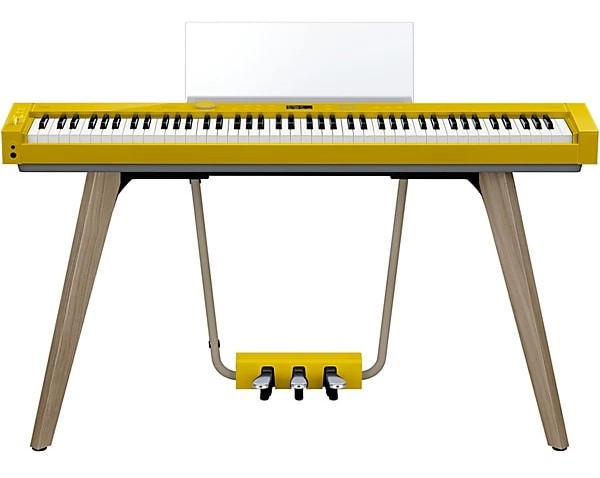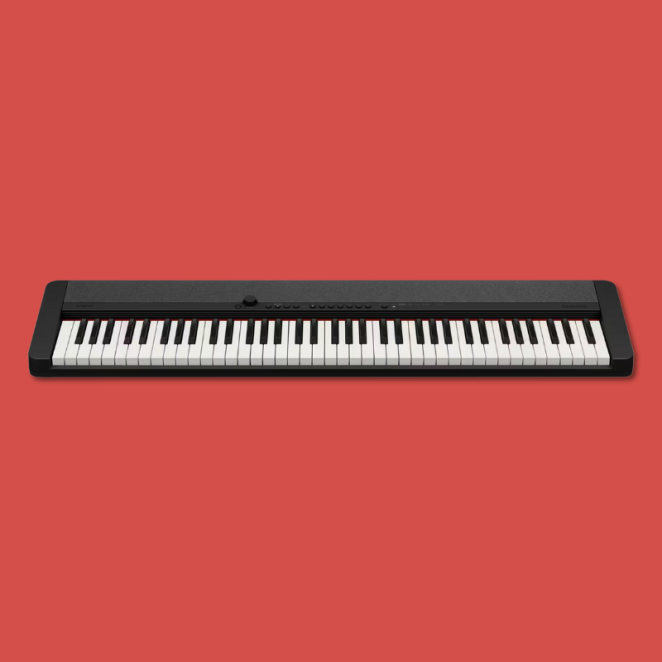Casio’s “spiritual successor” to the original Casiotone is lightweight and sleek—but packs just enough streamlined functionality to make it a worthy travel companion for beginners and hobbyists alike
The Casiotone CT-201 keyboard, touted as "the first electronic keyboard with full-size keys that anyone could afford" took the world by storm in the 1980s. Up until this point, Casiotone keyboards were small keyboards, with small keys, and as such were not really seen as “professional” keyboards (although this hasn’t stopped tons of bands from using them!).
The CT-201, along with the rest of the Casiotone line, was eventually discontinued, and for decades the Casiotone name was fondly thought of as a retro relic, nothing more. But that all changed when Casio re-introduced the Casiotone brand in 2019.
And now, Casio sports a whole line of reimagined Casiotone keyboards, including the beloved CT-S1, and now—drumroll please—the CT-S1-76. The CT-S1-76 boasts, you guessed it, 76 full-size keys, plus a streamlined library of tones and other crucial features that make it a traveling keyboardist’s best friend. Lightweight and packing a big sound thanks to a 13-watt bass-reflex stereo speaker system, the CT-S1-76 is a great choice if you're looking for a portable, simple keyboard for beginners and seasoned players alike.
Let’s take a closer look.
Quick Overview
Casio CT-S1-76 Key Specs and Features
SPECS:
- Keys: 76, Full-size
- Velocity Sensitive: Yes, 3 Levels
- Polyphony: 64 Notes
- Presets: 61 Tones
- Effects Types: 24 x Reverb, Chorus, Delay, DSP, 10 x Master EQ
- Audio Inputs: 1 x 1/8" TRS
- Audio Outputs: 1 x 1/8" TRS (main/headphone)
- USB: 1 x Micro B (host), 1 x Type A (device)
- Pedal Inputs: 1 x 1/4" TS
- Software: Chordana Play App
- Built-in Speakers: 2 x 5.11", 6.5W per side
- Power Supply: 8 x AA Batteries, AC Adaptor (sold separately)
- Height: 3.26"
- Width: 44.88"
- Depth: 10.15"
- Weight: 11.68 lbs
In a previous piece, I rattled on about how Casio’s Privia PX-S7000 is the crème de la crème, the Cadillac of Casio’s keyboard collection, if you will—due to its abundance of tones, gorgeous styling, and deluxe features. And, while that’s all still totally true, I’m now going to tell you about the… Prius? Of Casio’s keyboards: the CT-S1-76.
Why the Prius comparison? Well, it’s reliable, understatedly stylish, and it does a smaller number of things very well. Oh, and it’s like, really affordable. Actually a lot more affordable than a Prius. All of which is to say, Priuses are more popular than Cadillacs for a reason (at least where I live!). The PX-S7000 is a pricey pro instrument. It isn’t for everyone. But the CT-S1-76? It is for everyone. And I mean literally everyone. Here’s why.
Build and Hardware
Let’s work from the outside in. Available in black or white, the CT-S1-76 boasts an understated, yet stylish aesthetic that will fit in with pretty much anyone’s décor. Its control panel is minimal (gone, thankfully, are the days of every tone and beat printed on the top of the unit), with a simple row of buttons to control your tone selection.

In contrast to, well, most things these days, there is not so much as a screen to be found! This is a keyboard with the focus on PIANO keys, not the other kind, which, in my opinion, is a godsend. (We all spend enough time on screens already.)
But that doesn’t mean you have to sacrifice versatility. That’s because you can sync your CT-S1 with the Casio Music Space app to customize your setup to your heart’s content. So, if you want a screen, you can use your phone or tablet with either USB or Bluetooth to control your CT.
The 76 full-size keys have three sensitivity settings. They’re lightly textured for a more realistic feel, but their plastic construction is still noticeably more lightweight to the touch than the wood/plastic composite keys on the Privia. No matter, though, really—because the name of the game here is lightweight, with the CT-S1-76 weighing in at just under 12 lbs.
Most of the upper panel is home to the CT-S1-76's 13-watt bass reflex surround speaker system. More about this in the next section, but it's worth noting here that a significant chunk of the real estate that could have gone to onboard screens and menus went toward making the CT sound great, rather than loading up on settings and controls.
There’s a music rest and—yes—power supply included, but you can also opt to power the CT-S1-76 with 8 AA batteries on the go.
FUNCTIONality(?)
The heart of the CT-S1-76 is the stereo grand piano. This setting features a “German concert grand piano placed in a virtual concert hall,” which can be played in SURROUND mode to pretty impressive effect. The 13-watt bass-reflex stereo speaker system sounds really, really nice—I’m sure my neighbors think I got a real piano.
My (and my wife’s) favorite way to play is with headphones, though, and this is where the tones really shine—no shade to the onboard speakers. It’s just a personal preference that allows me to get deeper into the zone (because this is when I know no one is judging my playing).

So, while this is a piano player’s instrument through and through, there are 60 additional tones you can tap into, including some really cool vintage keyboard sounds (pretty much all I use besides piano anyway) and even some classic throwback Casio tones! The way the tone switching is laid out is easy enough to grasp: select your base instrument tone, and then you can switch through variations like "modern" and "vintage."
But... about that pared-down control panel. The FUNCTION button holds a vast reserve of, well, functions, that add a ton of value to the CT’s playing experience—if, that is, you can figure out how to use it. Initially, I almost missed the importance of this button—because, well, when I pressed it, it didn’t do anything.
I was sure that, upon consulting the manual, I would find what I was looking for. Not so!

I suspected that the FUNCTION button would be the key to unlocking the reverb, delay, room size, and other effects I had read about, so I persisted, downloading the Music Space app in hopes of getting to the bottom of this mystery. But then I struggled to connect my keyboard to my phone, which was a whole other rabbit hole of troubleshooting. The app does seem really cool and useful, though, if you can get your Bluetooth to connect or have the proper connectivity hardware on hand (I didn't).
Eventually I managed to cycle through the functions by holding the FUNCTION button while pressing random keys (you can also select your tones via the piano keys as well, it turns out). But without a visual guide to accompany my random plunking, I wasn’t really able to select anything in particular, and so it wasn’t a super useful experiment.
What Could Be Improved
Unfortunately, a streamlined design can come with a bit of an adjustment period as users come to learn the shorthand for calling up their favorite tones. With the CT-S1-76, getting to your favorite tones takes a combination of button pushes that aren’t the most intuitive or fastest way to find your sound.
As I mentioned above, I also struggled with finding the exact purpose of the FUNCTION button, and had to do a bit of research to figure out what exactly it did.
So while the extended functions are appreciated (once you find out where they are), I think this keyboard is best taken at face value: a great budget keyboard with good basic sounds that’s perfect for beginners, traveling hobbyists, and people who just don’t need their keyboard to do all that much (we exist!).
It also doesn't include a stand or a carrying case, which left me kind of wondering where to set it up at home (the kitchen table?) and, likewise, how to safely tote it to my studio.
Also Consider

Casio Privia PX-S7000
The PX-S7000 combines gorgeous design and high-quality components with a compact and easy-to-assemble construction that makes it the perfect 88-key choice for apartment living and cramped studio spaces.
Wrapping Up
The Casio CT-S1-76 is, again, a great choice for beginning or hobbyist keyboardists looking for an affordable, portable choice that's going to give you enough room to stretch out on, and with some great tones to boot.
While I struggled a bit initially with the pared-down controls, I think—ultimately—on a keyboard like this, the fewer distractions, the better. Stick with the readily accessible onboard tones and play until you love it—then take a deep dive into the FUNCTION button and all it holds, if you dare.
My theory: there's a reason why Casio kind of hid these features. They're there if you need them, and that's great—figure it out, if you really want to. Me? I'll stick with the grand piano, on SURROUND.




Comments
Loading…